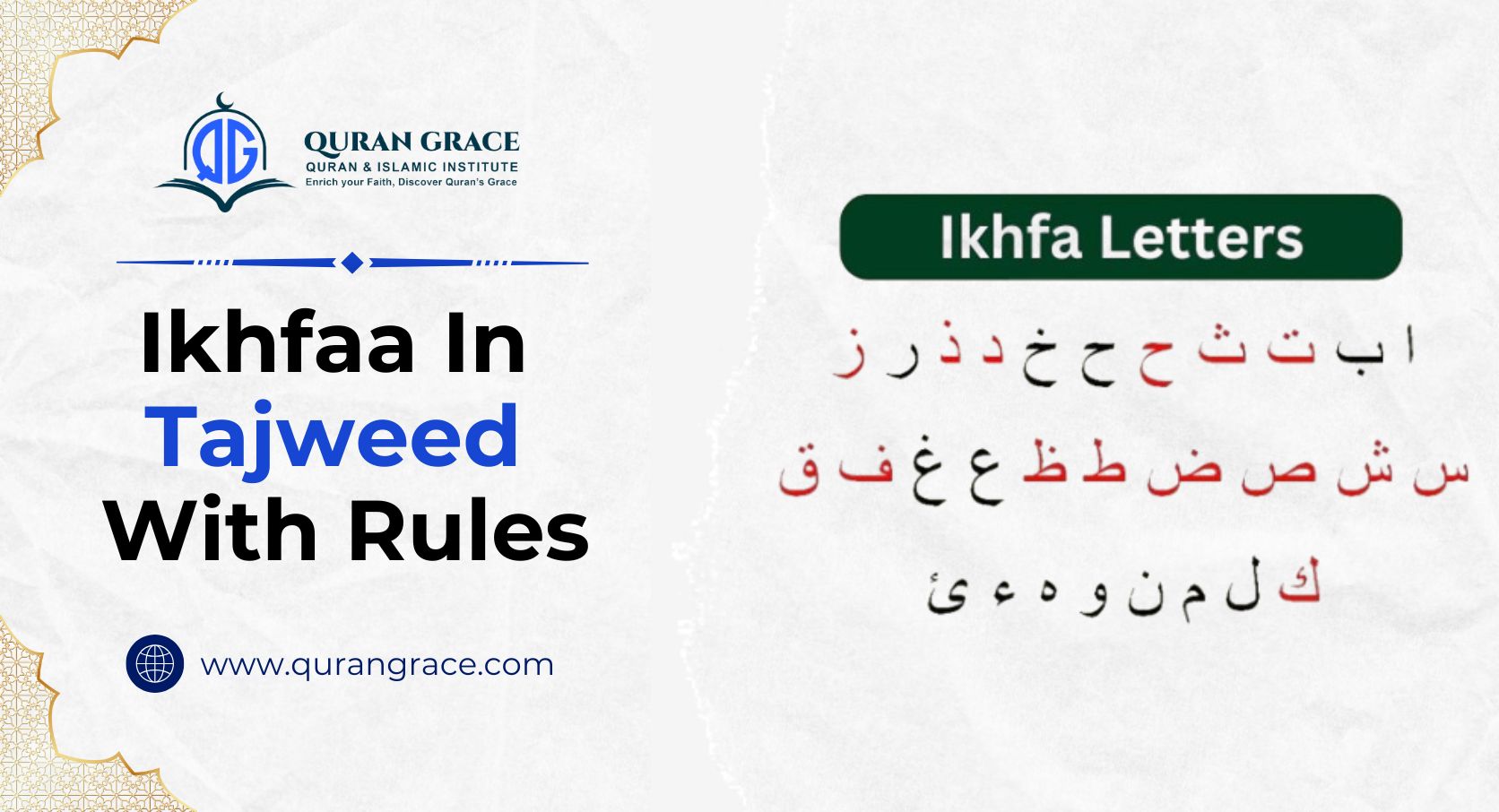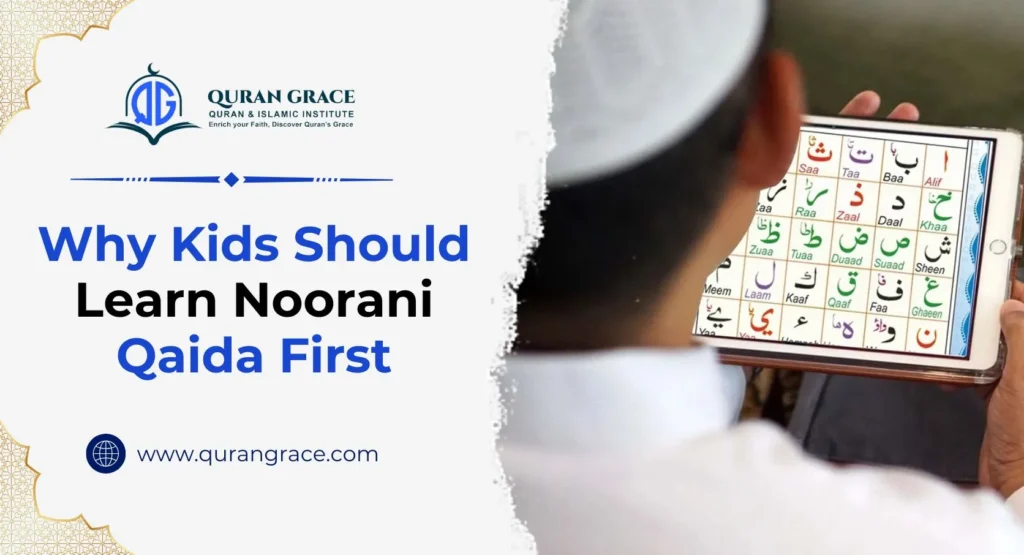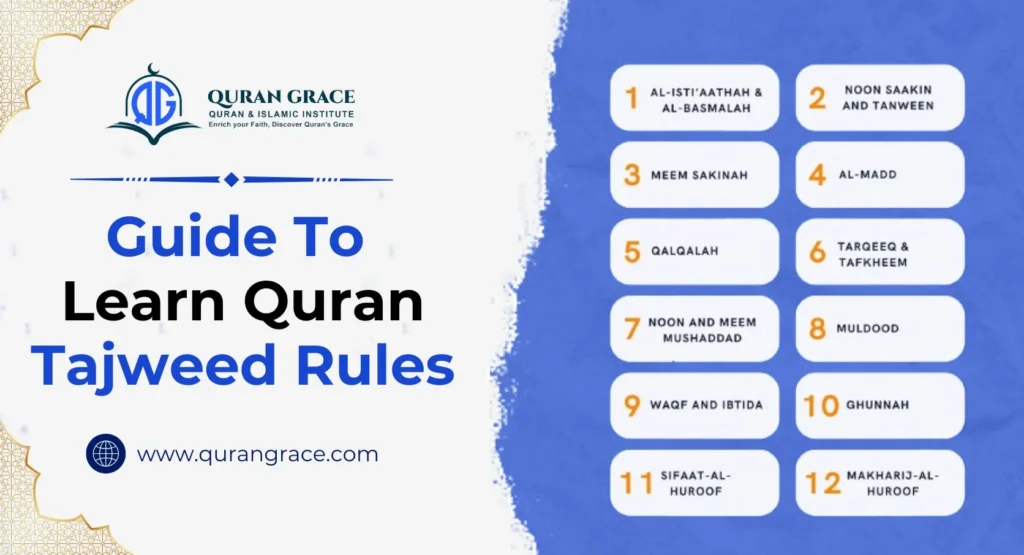If someone intends to learn the Tajweed of the Quran and recite it beautifully, they need to learn all the important rules that mark the perfection of the Tajweed. Ikhfaa is one such important rule to learn and master through the application of Quranic verses. The rule lies in between the other 2 major Tajweed rules of Noon Sakinah and Tanween, Izhaar and Idgham. Let’s learn about the details of Ikhfaa with rules and examples from the Quran.
Table of Contents
ToggleIkhfaa in Tajweed
In Tajweed, Ikhfaa is a technique that involves the smooth blending of specific sounds as one transitions between letters. Ikhfaa means to hide or conceal the sound. This method becomes particularly significant when encountering the letters “Noon Sakinah” (the noon without a vowel sound) or “Tanween” (the nasal endings marked by double vowels) in the context of recitation.
Ikhfaa Meaning
Ikhfaa means to hide, conceal, or partially obscure the sound of certain letters, resembling the way silent letters are treated, yet still allowing the nasal sound to be distinctly audible.
This technique creates an elegant flow in recitation, ensuring that the listener can appreciate the beauty and rhythm of the Quran. It serves as a harmonious middle ground between two other Tajweed techniques: Izhaar, where letters are pronounced clearly and distinctly, and Idghaam, where sounds are merged seamlessly. This careful balance enriches the overall experience of Quranic recitation, adding depth and precision to the performance.
Letters of Ikhfaa
These fifteen letters are considered to have a clear and distinct hidden pronunciation. When any of these letters come after Noon Sakinah or Tanween, Ikhfaa Haqiqi is applied. These letters are:
- ت (Ta)
- ث (Tha)
- ج (Jeem)
- د (Dal)
- ذ (Dhal)
- ز (Zay)
- س (Seen)
- ش (Sheen)
- ص (Saad)
- ض (Dhad)
- ط (Taa)
- ظ (Dhaa)
- ف (Fa)
- ق (Qaf)
- and ك (Kaf).
Note: Quran Grace offers online quran recitation course specifically designed to teach Tajweed rules with proficiency.
Types of Ikhfaa in Tajweed
There are two types of Ikhfaa in Tajweed. To understand this rule fully, you need to understand the types clearly. The difference between the two types lies in their pronunciation:
1. Ikhfaa Haqiqi
Ikhfaa Haqiqi, also known as clear Ikhfaa, involves concealing the sound of noon sakinah or Tanween when followed by one of the fifteen specific Arabic letters. Have a look at the examples to understand Ikhfaa haqiqi.
Noon Sakinah Examples
- Saad (ص ): The word “وَالْأَنْصارِ” has a Noon Sakinah at the end, followed by the letter Saad in the same word.
- Taa (ت): The word “أَنْ تَعْتَدُوا” has a Noon Sakinah at the end of the word “أَنْ”, followed by the letter Taa at the next word.
- Dhaal (ذ): The word “وأنذرهم” has a Noon Sakinah at the end of the verb, followed by the letter Dhaal in the same word.
Tanween Examples
- Thaa (ث): The phrase “قَوْلًا ثَقِيلًا” has a Tanween at the end of the noun “قَوْلًا”, followed by the letter Thaa in the next word.
- Dhaal (ذ): The phrase “بسلامٍ ذلك” where the noun “بسلامٍ” has a Tanween at the end, followed by the letter Dhaal in the next word.
- Zaa (ز): The phrase “نفساً زكية” has a Tanween at the end of the noun “نفساً”, followed by the letter Zaa in the next word.
2. Ikhfaa Shafawi
Ikhfaa Shafawi, often referred to as oral Ikhfaa, is a technique used in Arabic pronunciation where the sound of the letter Meem Sakinah (م) is concealed when it comes before the letter Baa (ب). This method is called Ikhfaa Shafawi because both letters are articulated in the same manner, with the sound produced using the lips. Let’s look at the examples from the Quran.
- لَسْتَ عَلَيْهِمْ بِمُصَيْطِرٍ (Surah Al-Qamar, 54:14)
- فَذَكِّرْ إِنَّمَا أَنْتَ مُذَكِّر (Surah Al-Ghashiyah, 88:21)
- مِن فَضْلِهِ (Surah Al-Baqarah, 2:261)
In essence, Ikhfaa Haqiqi involves the concealment of specific letters following Noon Sakinah and Tanween, while Ikhfaa Shafawi specifically deals with hiding the sound of Meem Sakinah when it precedes Baa.
Take advantage of online platforms such as Quran Grace to effectively learn Tajweed and become proficient in applying Ikhfaa rules when reciting this holy scripture.
Three Main Rules of Ikhfaa in Tajweed
Ikhfaa has three distinct levels. The levels of Ikhfaa in Tajweed are influenced by the articulation positions of the Arabic letter “Noon Sakinah” (silent noon) and the Arabic phonetic sign “Tanween” (a double vowel sound). Each level corresponds to specific Arabic letters and their places of pronunciation.
1. Rule for letter ق ، ك
The easy or the initial level of Ikhfaa is applied when Noon Sakinah or Tanween is succeeded by the letters (ق ، ك). Here, it bears resemblance to Al-Izhaar, since the pronunciation points for these two letters are distinctly distant from the articulation points of Noon Sakinah or Tanween.
2. Rules for the 10 Ikhfaa letters
This intermediate level manifests when any of the ten Arabic letters: ث , ج , ذ, ز , س , ش , ص , ض , ظ , ف follow Noon Sakinah or Tanween. It is characterized by articulation points that are neither too close nor too far from those of Noon Sakinah or Tanween.
Understanding these three levels of Ikhfaa in Tajweed is vital for the proper recitation of the Quran. By identifying the circumstances in which each level applies, learners can effectively implement the rules of Ikhfaa and enhance their recitation skills.
3. Rules for د ، ت ، ط
This level arises when Noon Sakinah, or the Tanweensign, is followed by the Arabic letters (د ، ت ، ط). In this situation, Ikhfaa resembles Al-Idghaam, as the points of articulation (Makharaj) for these three letters are close to those of Noon Sakinah or Tanween.
Conclusion
Grasping the rules of Ikhfaa in Tajweed is essential for anyone looking to recite the Quran correctly. By getting a handle on the pronunciation of the 15 letters that encompass Ikhfaa and being able to spot it in the Quran, learners can significantly improve their recitation skills and deepen their connection with the sacred text.
If you’re ready to dive into the world of Tajweed learning online with experienced instructors, consider enrolling in the famous Online Tajweed classes at Quran Grace. So, join tajweed classes for adults, tajweed for children, and online tajweed classes for sisters to discover and develop your skills and enhance your quran learning today.








